Made in CA: The Manley Schematic
Heat rises from the LA freeway. It’s a cool 90-something degrees in Pasadena and my guess is Chino won’t be much cooler.
EveAnna Manley, and Manley Vice President Zia Faruqi, give me a run down of the days events as we carpool-lane-it past strip malls on the right and mountains on the left.
It’s 9:45 am and the drive goes by rather fast, particularly in a Maserati.
Between revs of the engine, I begin asking questions about the history of the company. Unlike the smooth and sleek finishes of Manley gear, their beginnings were a little more gritty and imperfect.
The first pieces of Manley gear were actually made under VTL (Vacuum Tube Logic) where EveAnna was hired onto the production team in 1989.
“When I first started working at VTL back in the day, there was no purchasing system, no inventory,” Manley recalls.
“I remember watching the purchasing lady at a frame shop I worked at in high school – she had a paper system for suppliers. So, I took out a sharpie and a ruler and I made a similar system, copied the sheets and put it in a binder, and said, OK, here’s your new purchasing system. That evolved into an excel system, then File Maker.
“I developed a lot of these systems on my own. I didn’t study this stuff in school, I just noticed. A lot of this kind of stuff is just about awareness, and solving problems.”
Solving problems proved to be one of EveAnna’s keystone strengths. In 1993, when Manley Labs officially split from VTL, she spent the first month typing and faxing everyone she could find business cards for, trying to get sales going for the fledgling company.
“I remember running the factory the first month. I went in there and said, ‘hey guys what orders are you working on?’
‘Orders? What orders?’
So, there’s this factory where everyone’s making stuff but no one’s selling anything. There were no salesmen. What’s gonna happen on Friday when you want a check? Can I pay you in resistors?”
Luckily, she didn’t have to dole out resistors, and the factory gradually got more organized and efficient under her supervision.
It’s that same factory we are on our way to now.
As we pull off the freeway into clusters of corporate parks, EveAnna points out some other local companies and factories she works with manufacturing the Manley products.
“Most of the dollars in the unit are coming from here in California. All the metal work is done here locally. The finishing and polishing are done in house. The anodizing is done just here in Ontario, CA.
Powder coat is done locally too. Milling, sheet metal, and some of the knobs are done just here in our business park. Power transformers are made in Willits, CA up north. All the audio transformers are made in house. So, if you look in any unit, the real dollars are local.”
“’Made in Chino, not in China,’” she says with a smile.
Attention To Detail
Despite the fact that many pro audio companies outsource to China and other countries, Manley was, is and will continue to be made a half hour from where the company’s owner lives. And that is an important detail to EveAnna.
But it’s just one of the many details that – with EveAnna’s attention – have enabled Manley Labs to go from paying a week’s worth of employee salaries out of pocket to the successful, organized, reliable, and creative pro audio company that it is today.
Walking around the factory floor, she shares some of these details with me, like knobs and RCA jacks; transformers made in house, specifically designed by Manley to be better than whatever’s already out there.
There are highly organized wire kits, not to mention a machine that can spit out 25 stripped and measured pieces of wire in the time it takes to have a sip of coffee.
The chassis pieces come quite literally from the room next door, finished and polished, landing eventually on a bench used solely for bolting the chassis together. Organized carts stand at the ready, with parts kits and read outs of orders, schedules and any missing components.
Pieces of gear line the shelves marked “Copy” so that someone can easily reference a master while building. Inventory is streamlined in File Maker Pro, using some sub-programs designed by EveAnna for her company’s needs.
In the middle of the tour, she notices a mistake and without hesitation, shifts focus to deal immediately with the issue at hand. Once a resolution is reached, she picks up where she left off, literally giving me an inside look to the newest updates to one of Manley’s best-selling pieces, the Variable MU stereo limiter/compressor.
“We just made some changes to the Variable MU. For the input/output and the bypass, there used to be Mogami wire going up here and back to the bypass switch and that’s just almost two feet of wire that you don’t need to be listening to, so we’ve redone that with two relays.”
She continues, discussing the melting point of plastic around a particularly hot area of the unit. Once again, the attention to detail here is exacting. It’s something engineers, and even techs don’t always think about. Even the angle of the resistor, sitting off the board but not too close to a capacitor, is important to the functionality and longevity of that piece of gear.
This Is Not A Plug In
As we make our way around the factory floor, she stops to highlight how the industry’s mentality has changed over the past two decades, thereby changing the way Manley operates and designs.
“Now, 20 years ago we had a stereo pot on the input of the Variable MU. These pots are 20% tolerance parts, so they could be all over the place. With that, the tracking might be ¾ of a dB off, then it’s on, then it’s about 1.5dB off. The two pot’s values would change and that’s how pots are.”
“Back in the old days, people were mixing with their ears, not eyes. So if you’re using the unit, and you hear it a little louder on the one side, you just turn the output control up to compensate or back down on the threshold, just a little bit.
“Now, in the last while, people are looking at the computer and the meters, and they’ll say, ‘there’s something wrong with this Variable MU. I just ran tones through it and one channel is one dB different than the other.’ Well fuck it, just turn one up a little and it’ll be fine.
”No, something’s broken. I want a new one.’”
She motions to an employee sitting at a bench with a potentiometer jig, checking a digital read out of the pot’s tracking error between L/R.
“Then, we’re measuring pots like he’s doing now. All these people started complaining about it being a dB out so then we start pulling the pots apart; front and back. We would pull them apart, log the information into File Maker and it would spit out and say ok, pot labeled 10 front is a good match for pot 470 back. Then half dB errors were too much, and it’s like dude, this is not a plug in! This is all organic, analog stuff. Finally I just said fuck all this, I’m gonna put a Grayhill switch in there with 1% resistors. And then people are like, oh I used to like it better when it was a pot.”
She shrugs, clicking the switch at the front of the Variable MU.
“They’ve gotten so used to computer perfection with plug-ins. That’s just math. They expect this to behave like a plug-in, like an algorithm. We’re doing everything we can to be as perfect as possible but guess what, you will pay for that. Because I gotta pay this guy to sit here and match pots. And the same with the Massive Passive. Someone has to go through all those coils. All the caps get matched in left and right pairs. There’s a little give and take on everything.”
EveAnna echoes a common feeling within the pro audio community. As Joe Barresi said, “engine-eyes not engineers.” When I relayed that to EveAnna, she laughed, nodding in agreement.
The Variable MU remains one of Manley Labs’ best-selling products, along with the Massive Passive and Reference Cardioid Mic. The changes she has designed and constructed to deal with the trajectory of the industry have proven successful. While she holds true to her analog roots in many ways, she gladly embraces many of the changes brought on by the digital age.
She mentions several times how Manley has improved by utilizing surface mount technology, for example. It’s not just cheaper, it’s technically better when you consider aspects such as the leads on a resistor. Take away the inductance from those leads, and that in turn gives you a lower distortion component.
Taking into consideration her local construction and the rise in the price of, in particular, the metal work associated with a single unit, saving money without cutting quality is essential.
For Manley, it won’t do to simply raise prices on the back end either.
Getting creative with changes, updates and new gear, while maintaining the high standard is at the forefront of Manley’s company philosophy.
New Customers, New Gear
While I can’t share anything about the new product I saw in development at the factory, I can say that Manley will gain even more clients with this new piece, particularly musicians and home studio owners. Opting for a more compact design that’s easy to use with no unnecessary bells and whistles, Manley is looking to broaden their fan base with lower prices, high quality and a simple, sleek unit.
“In the past, we didn’t care what it cost until we declared what it was gonna cost. We would just build and whatever the price was at the end, that’s what it was. Now, we set a price target.”
Younger, less experienced musicians and engineers may love the Manley brand, but can’t necessarily afford an $8K piece of gear.
With this new strategy of price targeting and design, Manley can maintain their audiophile and hi-fi status while opening the door to new customers in the industry. The lower the price, the more you’ll sell.
“We did this in the hi-fi range. We have this big phono stage called the Steelhead and that unit is $8K. So we took the basic circuitry of that Steelhead and shaved off all the switches and knobs, and extra PSU’s and engineered a $2,200 unit called the Chinook. It’s the same audio circuitry so it sounds 98% the same. The circuit is pretty much the same thing. We just engineered it from the onset to build fast and pop together and not be so fussy in the construction and then we’re able to hit the price target.”
Creative business thinking hasn’t just lead Manley to re-engineer her own gear, but also to collaborate with other companies on creating new and top-of-the-line pieces.
For example, when I asked EveAnna if all the products were her designs, she gave me some backstory on another one of Manley’s’ best selling pieces, the Reference Cardioid Mic, that came from a Steve Hazelton design.
“For me, I’ve always been open. Hey, you know more about this than we do. What can I do to work together with you? Some other companies have a lot of ego or mistrust with other people and they try to do it all themselves. There are no state secrets.”
“This stuff isn’t rocket science. It’s about being humble and knowing that hey, that guy knows a lot about this. I couldn’t even pretend to learn about that. So yeah, I wanna hire you to develop a kick ass product for us. And then working together, he ends up learning more too, because he hadn’t done one just like this before or encountered those exact problems.
So overall, the cost to build will be a bit less. With new technology, it will be a little less expensive than before, but also way more convenient, and far better performance.”
So, despite the Manley shirt reading “Tubes: I’m Biased,” it’s clear that Manley isn’t stuck in the past. She isn’t too enamored with the gadgets of the present either, however.
The balance of analog and digital is at a nice equilibrium in the Manley factory. Likewise is the integration of creativity and technical knowledge.
As she holds a Manley transformer in her hand, she explains an instance where this cross section of creative and technical prowess has really paid off.
“When I designed the Stingray amp, I wanted it to sound as big as possible. It’s a 40 W stereo integrated amp, so not that big. I didn’t like the old transformer and it was kinda weak in the bass so we ran calculations and measured and learned how to correlate what we’re measuring on the scope to what we need to change inside the unit to make it do that; that was a really cool thing.
So, for example, the old transformer measures really low distortion in the bass, but it’s kinda boring. Let’s back that down and let it introduce some distortion around 100Hz, let it saturate a little bit there. So bring down the flux density, the inductance of the part. We wound it, measured it, and yep, saw that distortion. OK, that’s what we wanted, that’s good. Listened to it, and it was like, yes, now I’ve got goosebumps, and you can’t measure that.”
She smiles, setting the transformer back down and showing me the rest of the transformer room, which began, as most things at Manley do, because it allowed for creative and technological experimentation and freedom in development.
Making our way through the prototype area, then the QC room, past boxes and bins full of neatly labeled and organized tubes and parts, we end up in EveAnna’s office where she puts some music on through the Manley Stingray iTube, another example of beautifully creative design and technologically forward thinking.
Taking the things you can measure and turning them into reactions you can’t measure is what every artist craves. It’s also what scientists crave.
At Manley, that duality is ever present, as much in the gear as in the creator and owner.
Eleanor Goldfield is a Los Angeles-based writer, musician and studio tech. She is lead singer in the hard rock band, Rooftop Revolutionaries, and chief tech at The Village Studios.
Please note: When you buy products through links on this page, we may earn an affiliate commission.







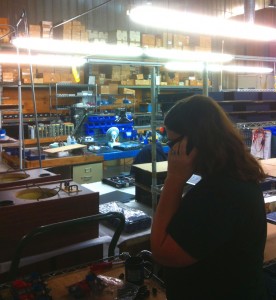
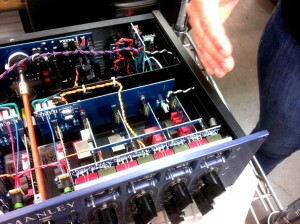
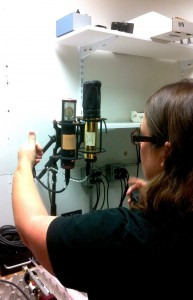
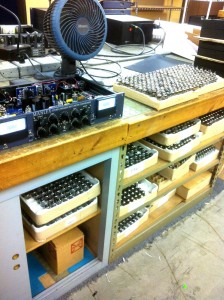
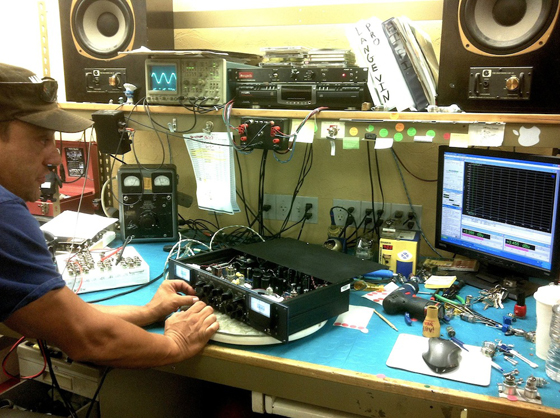
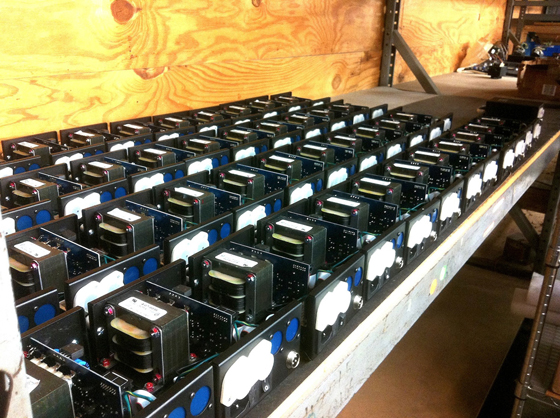
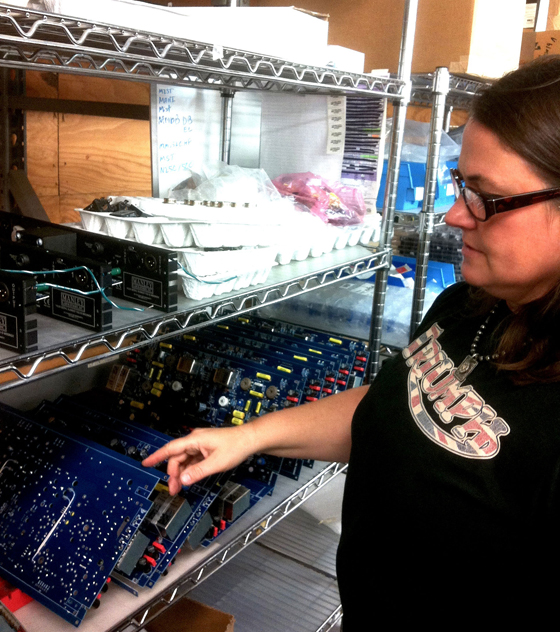

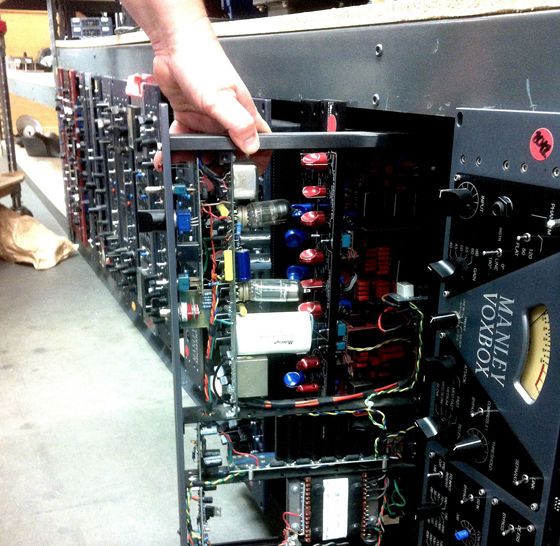
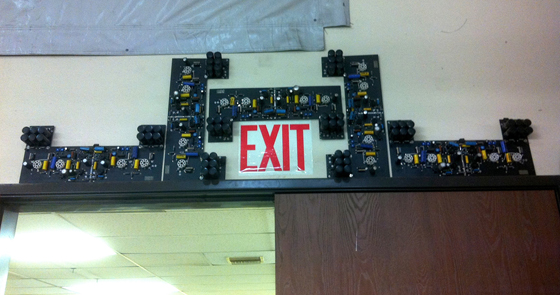
danwriter
September 19, 2013 at 1:00 pm (12 years ago)A story about a woman leading a pro audio company written by a woman. I like where this is going.